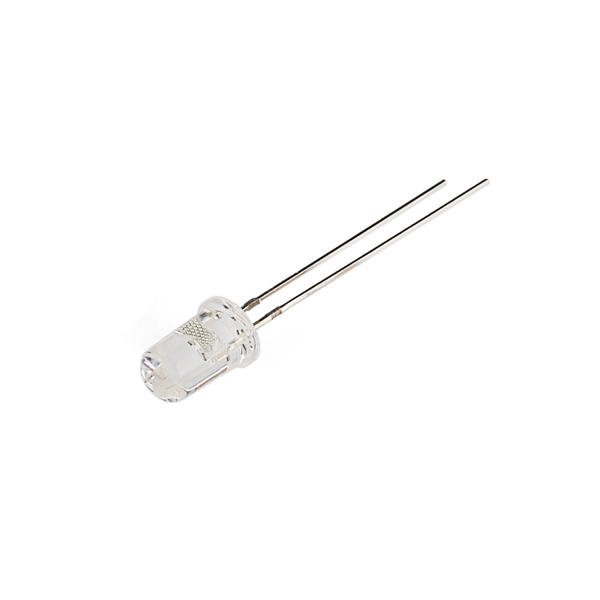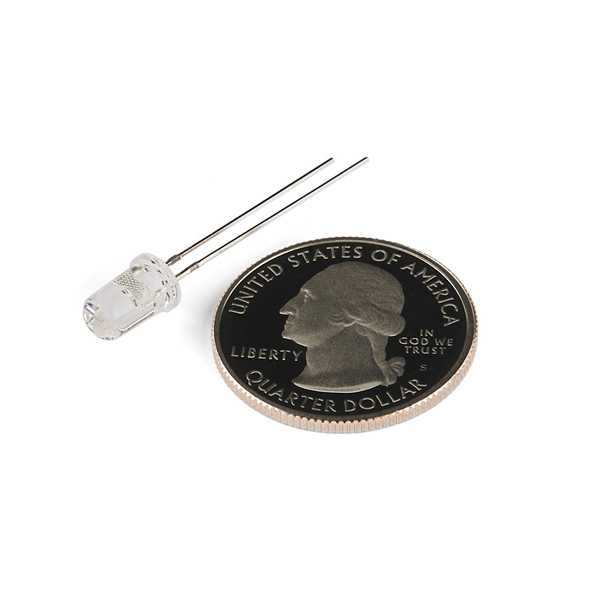These color-changing LEDs take the work out of creating crazy, flashy, blinky... ness. Simply apply power and the LED will cycle through the RGB colorspace: no external controller necessary! These bright and festive LEDs make great decorations, LED "throwies", indicator lights, etc. Typical forward voltage is 2V.
These 5mm LEDs are of the "slow-changing" variety, meaning they cycle at a rate of one color every few seconds.
LED - 5mm Cycling RGB (slow) Product Help and Resources
Core Skill: Electrical Prototyping
If it requires power, you need to know how much, what all the pins do, and how to hook it up. You may need to reference datasheets, schematics, and know the ins and outs of electronics.
Skill Level: Rookie - You may be required to know a bit more about the component, such as orientation, or how to hook it up, in addition to power requirements. You will need to understand polarized components.
See all skill levels
Comments
Looking for answers to technical questions?
We welcome your comments and suggestions below. However, if you are looking for solutions to technical questions please see our Technical Assistance page.
Customer Reviews
No reviews yet.



I appreciate this discussion and the more detailed one that was linked, but I am not an engineer and I just want to know what current limiting resistor to use with the 5mm LED. I am powering it with a CR2032 battery. Isn't there a nice average value that won't burn up my LED but will still make it look bright? Thank you.
Not sure if anyone is still monitoring the comments, but the datasheet link appears to be broken (for this and the other discrete color changing LEDs). Thanks!
Working now, thanks Funyuns!
Can these leds be slowed down by using capacitors or resistors? I am a newbie therefore please be specific.
Nope.
what type of resistor do these require, as some are for Red, Yellow, Orange and other are for Green, Blue and White?
Do these change abruptly between colors, or is it a fade cycle?
If I interpret the datasheet correctly, both. Alternately. And it doesn't cycle through all colors. I hope I'm reading that graph wrong.
What’s the right resistor if we use it with coin battery (3V) such as CR1225 or CR 2032? and how long would they last? thank you for your help in advance.
I am wondering how these react when dimmed through PWM. I am guessing that along with the light output getting dimmer the rate of cycle will also slow. That is a guess. Has anyone used these in a PWM application? Is my guess correct? Does anything else get screwey? I am intending to use 16 of these to be driven by a TI TLC5940 chip controlled by an arduino. This is only one piece of this complex lighting project, but I am wondering if this will work or not.
anyone know the least amount of current/ volts I need to run this LED? looking for battery longevity..
The 'least amount' vary and you'll start noticing that blue gets dimmer, then green gets dimmer, until you're left with a very faint red that still cycles according to the color cycling programming. You'd have to check what amount off dimming on the colors is acceptable to you in order to answer your own question :) Keep in mind that you can't classically PWM these, so that route of sparing the battery is a no-go.
newbie question: when calculating the current limiting resistor, what value do I use for the forward voltage? The red LED has Vf typical 2.0 and max 2.25, but the green and blue LED have Vf typical 3.5 and max 5.0.
this tutorial should help you out.
RobertC, the Cycling RGB LED has three different LEDs in one package. The different LEDs have different forward voltages, according to the datasheet. So which one do I use to calculate what resistor to attach to this LED, the lowest value?
I have written a discussion comment to the tutorial that addresses that question from a more generic perspective, but to answer your question within the context of this specific product:
The datasheet includes the figures for the RED, GREEN and BLUE colors you mentioned. However, it also includes a table that is intended for circuit/the entire device, and these are the values you would use to determine how to drive the LED as a whole. The table notes a drive characteristic of 50mA@4.5V . Though this is not actually the same as a forward voltage, and the current draw varies depending on color displayed, it is Close Enough™.
Kamiquasi, thank you. That is what I wanted to know.
Are these in your Eagle library? I don't see them.
Yep - Just look for the standard 5mm LED, these are the same footprint and package.
Thanks!
How does one power these? Constant current, current limiting resistor, or constant voltage? The spec sheet does not specify. Maybe I need to experiment and destroy a few...
Same as any other LED - 'constant' current.. a current limiting resistor will do just fine :)
"We didn't find anything that matched LED - 5mm Cycling RGB (Slow Blink) pack of 25" Notice that it said "PACK OF 25" but aparently that doesn't exist yet , suggestion . Thank You Spark Fun for being a degree of Awesome .
One of the most useful components that I've used for little LED projects has been the lovely blinking red LED. These allow a simple implementation of a function that might otherwise take several handfuls of parts. Here's an example part: http://www.lumex.com/specs/SSL-LX5093BHD.pdf
There's 2 other interesting properties of simple blink LEDs.
They're horribly unstable. That is to say, take two consecutive LEDs from the same production run, hook them up, and one is still going to flash at a very slightly different frequency than the other. If that's not desirable, these are not for you. If it is - free variant-frequency without separate frequency generators on your uC or in your circuit. ( If you did want something more controllable but with little involvement, check out something like the PCA9552 - 16-bit I2C-bus LED driver with programmable blink rates. )
This is practically never noted in datasheets (they are, after all, intended only as indicator LEDs, like a (fake) car alarm), but some of these flashing LEDs actually go into high-Z when they're in the 'off' period of the blink. You can then stick any other LED behind it to make it flash, or control a relay (through a FET), etc. There's a few gotchas (voltage drop, etc.), but it can be fun to play with if you can find some (a batch of flashing yellow LEDs we used for an automated gate warning indicator strip didn't, which thankfully meant we could group 3 together in series for a simpler circuit - but does mean the fun shenanigans wouldn't work with them).